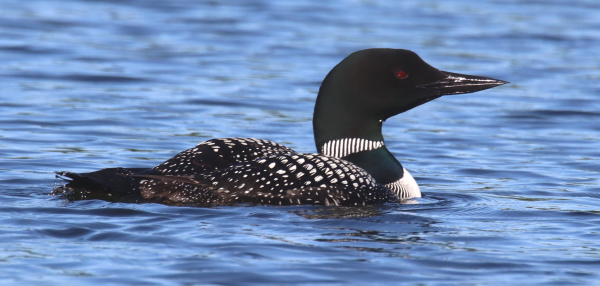
A regal waterbird, in some lighting positions a Common Loon can look very black and white in color. It can also be difficult to show the red eye color in some positions (f8, 1/1250, ISO 400).
As described in detail in the Editor Afield article in this week’s issue, after making an initial plan to travel to central Minnesota to photograph Common Loons, I was rewarded with a perfect morning of photography under near-perfect conditions in the company of 2 of my best friends. What more can you ask for? The weather wasn’t a given, the sunlight wasn’t a given, the loons weren’t a given, the windless lake certainly wasn’t a given, and my Portland amigo might have been the biggest surprise, but it all came together in one brilliant package Friday morning.
With Andy as the pontoon captain and Dwight and I as enthusiastic Minnesota lakes visitors, we concentrated on photographing a particular Common Loon that was accepting of our position on the calm morning water. Overall, there were many elements that made this a super-successful and enjoyable bird photography outing, and I’m going to share those elements in a more structured way than I often do here. This approach should make it a little simpler and a bit easier to refer to this information if you wish to check back another time. So here goes:

In full sunlight, the red eye is prominent and colorful highlights are created that add green hues to the head and lower neck. The varied colors reflected in the water can also add different looks to photos of the same bird (f8, 1/400, ISO 400).
Weather – The availability of sunlight is often dictated by weather, so it’s best to plan any photo trips using a dependable weather predictabilitator. You need morning and/or late afternoon sunlight in the weather report, and it’s best to venture afield when the wind is less than 15mph, even better when it’s less than 10mph, 5 or less is perfect. That’s what I planned for, and while my usual field days of Wednesday and Thursday were super windy, Friday looked especially promising with full sunlight and light wind predicted – bingo! Morning would be the best bet for photography, when lighting would be good and wind would be less of a factor; and we might have the lake to ourselves before other boats geared up.
Timing – Mid-morning or late afternoon hours provide the best sunlight when it’s not cloudy. During that period the sun is at an angle that provides light from the side, making shadows less of a factor if you are positioned between the sun and the birds. Morning hours tend to be calm, or at least have calmer breezes that tend to build up around noon and thereafter. The amount of wind tends to dictate how calm the water is, and when photographing swimming birds, calmer is often better. Wind conditions were an especially important consideration for this loon photography trip because the days prior to Friday were terribly windy, as were the days after Friday. How I lucked out with a windless morning with a light breeze the rest of the day was pure luck. But the Weather Channel app really helped when I checked the weather prediction 4 days in advance and each day thereafter.
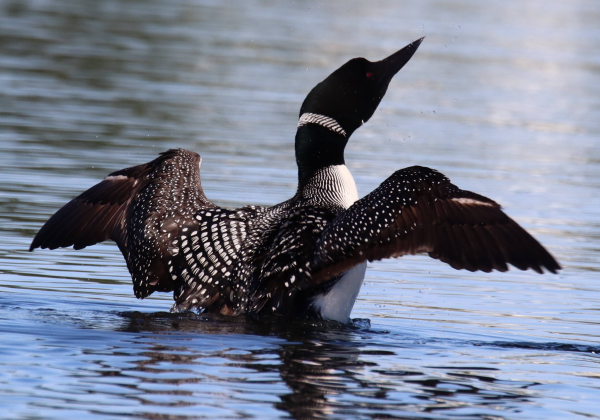
Although consumed by preening and to a lesser extent bathing, the best opportunities for action photos came when the loon would rise up and flap its wings, which may have some territorial connotations (f8, 1/1250, ISO 400).
Water – Again, calm water is a big plus; water color is dictated by what’s being reflected by the water. In open areas it will be blue sky on a sunny day, or gray sky if you opt for photographing when it’s cloudy – but go for the blue water look. In my case, we had the opportunity to photograph the loon swimming in blue water, as well as an area where trees and other vegetation that lined the shoreline were reflected on the water surface, coloring the liquid green, yellow-green, or dark green. Even if these colors are less desirable to you, it’s worth taking advantage of the options if a bird is swimming through ‘green water’ rather than a bright blue lake surface. Any wind or breeze will break the water’s surface, adding some ripples of color and even tiny wavelets that can create some nice patterns in the water surrounding a loon or other water-associated birds.
Lighting – Again, the mid-morning and late afternoon hours provide the best sunlight when the sky is clear. That’s when the sun is at an angle that provides the best quality of sunlight from the side, making shadows less of a factor if you are positioned between the sun and the birds. If straight up is 90 degrees, and the water is 0 degrees, think optimum light is between 30 and 60 degrees, maybe 30 to 45 degrees is better yet. But that’s optimum, and sometimes I get surprised by the quality of the light beyond those best case scenarios.
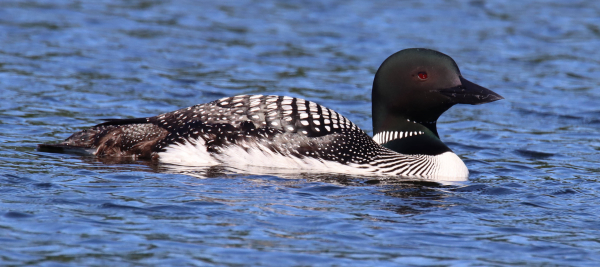
The laid back, calm, and relaxed qualities of this image show the loon was accepted our distant position during the morning photo session. The head plumage shows a plush or satin-like quality with added hues of blue and even pink (f8, 1/800, ISO 400).
Shadows – Always be aware of shadows and try to avoid them when possible; shadows from the bird, from nearby plants, and other elements. Shadows are always emphasized darker in photos than what our eyes perceive. It’s good to get in the habit of being aware of shadows and shade when you are photographing, and sometimes a step to the right or left, or just leaning right or left, can help eliminate a shadow on a bird. Then too, I always emphasize using your shadow to be your guide when photographing. To ensure the sun is at your back check your shadow, and ideally it should be pointing at your subject.
Colors – Light produces colors, and the best light produces vivid colors. Too much light can wash out colors, and not enough light can make colors look dull. Overhead light will produce shadows, and shade and shadows dull colors in big ways. While photographing the loon, the angle and direction of the sunlight, as well as our relative position between the sun and loon provided true colors and no shadows on the loon. In low light cases or when the light is not coming from the right angle, Common Loons can look very black and white; but in full sunlight, colorful highlights are created that add green hues to the head and lower neck ring, and the head plumage can take on a “plush” or satin-like quality with added highlight hues of blue or even violet, show the iridescent quality of some feathers. This light can also add a sparkle to the loon’s bill and a white spot in the eye as the sunlight plays its magic on the bird.
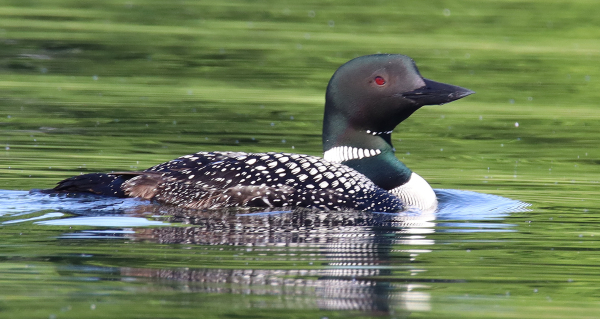
In this beautiful photo, the lighting of the front part of the loon shows maximum color highlights in the head and neck, all of which changes as the loon moves its head to one side or the other. The eye and beak are prominent, and the shape of the head is emphasized by faint shading (f8, 1/320, ISO 400).
Bird Photo Ethics – The birds come first, so pass on a photo attempt if you see a bird is not acting naturally, trying to flee, or about to fly. Also pass if you think you might disrupt a bird that is feeding or hunting, has hatchlings or fledglings with it, or if it’s near a nest site. Using a long telephoto or zoom lens should get you the photos you want without disturbing a bird, plus you can always enlarge the image of a bird by cropping extraneous background and foreground after you have taken photos.
Cropping Closer – Keep in mind that you don’t need to fill the photo frame with the bird. It’s always nice to show a bird within some surrounding habitat. And don’t forget that you can always enlarge the bird and reduce the surrounding landscape by using photo editing software to crop some extraneous background and foreground from the photo frame. While cropping, be aware that rather than centering a bird in the photo frame, leave a bit more space in the direction it is looking or moving – see what you think.
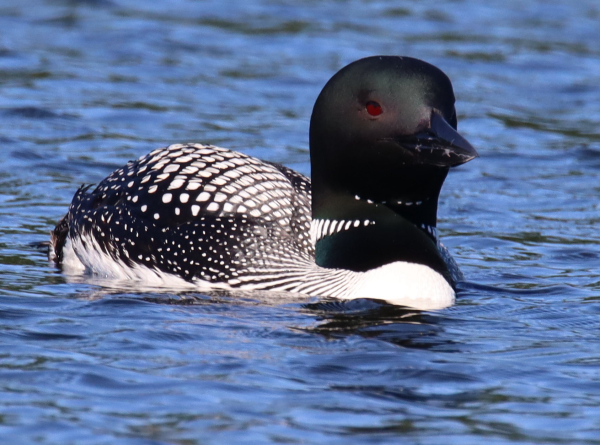
As the loon swam closer with a head-on angle, it provided some exceptional images that obviously showed different perspectives.
Proximity – Any birds can be wary, if not fleeting, but if you minimize your approach via size, sound, and action, keep your distance, make any movements slowly, avoid moving directly toward it, watch the birds’ behavior to be sure it doesn’t show concern with your approach, and try to anticipate where the bird is going, you may be able to position yourself or your boat or vehicle so the bird will actually approach you. The key is to try not to do anything out of the ordinary, to take your time, keep noise and motion to a minimum, and keep your distance – especially at the beginning. Get into position in small increments, and rather than following the bird directly, stay to one side, or in a round-about way you can try to get ahead of the bird without blocking its approach or affecting its movements or direction.
Our Approach – That’s the way we 3 Amigos moved into position with the Common Loon I photographed. Andy was a perfect pontoon captain for photography, he seemed to know instinctively what to do after I provided a quick pointer to keep the boat parallel to the bird with the rising sun at our backside and the loon to our frontside. He kept the motor at a low hum, inched forward almost motionlessly, stayed on the sunny side of the bird, and we always gave the loon plenty of space so it really never swam away from us or dived as a result of our positioning. In fact, it spent most of its time preening and bathing while we watched and photographed, which is always in indication that a bird is at ease and behaving normally. A couple times bird swam a little closer to the boat, and we repositioned a couple times to try to keep up with its movements when it did move a short distance. It’s always a rewarding feeling when birds accept your presence and permit you to share a little time together.
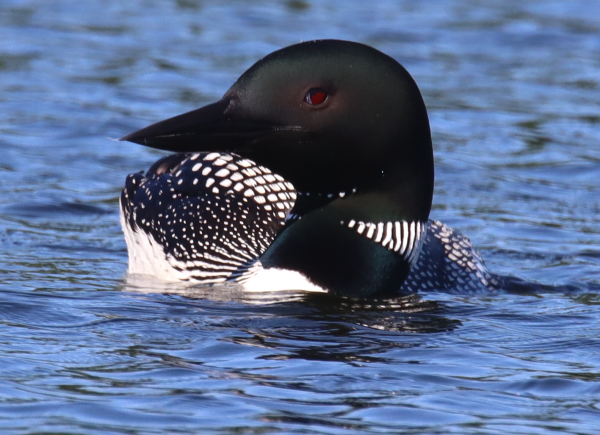
The black and white patterns and subtle hues against the black head and neck plumage give this image a special quality.
Action – Once in position, I took an assortment of classic loon portraits, but I was also ready to document any action that might transpire – swimming, diving, preening, flapping. The best action we witnessed was at the end of one of the continuing preening and bathing sessions. After enthusiastic preening of its plumage from neck to tail, top to bottom – activity that included considerable rolling this way and that on the surface of the water, often showing its bright white underside – the loon would usually do a little bathing action in which it dipped its head, neck, and body just under the top of the water and moved its slightly open wings at the same time in bird bathing fashion. Then, after a moment’s pause, the loon would rise up to fully spread its long wings in all its glory, only to erupt into a series of flaps, which provided the best photo action of the day. After the loon repeated the wing flaps a few times, I pointed out that the loon always faced away when it flapped, and didn’t face us for a different perspective, but maybe next time.
Relaxed Bird, excited photographer – The fact that the loon’s primary activity while we were in photo position was preening and bathing showed the bird was not concerned with us and enough at ease to carry on with its regular routine. Every once in a while it would dip its head beneath the surface, probably to search for fish or for another reason, but it never went into hunting (fishing) mode during our photo session. Unlike the loons at Linda’s lake the night before, this loon never called. I didn’t here a loon call the night before, or as we prepared for the pontoon cruise that morning, or while we were on the water. My take was that the loon didn’t have other loons to contend with on this lake, so perhaps it didn’t want to draw too much attention during the nesting period.
Be Prepared – Just in case, any time you are on the water, it’s a good bet to take a hat, windbreaker jacket, sunscreen, mosquito spray, and cortisone cream (in case you get a mosquito bite or 2), plus a cool bottle of water, and you should be set. But different locations and times of the year, plus personal needs or preferences will dictate different preparations for different people.
Sharing – Whenever possible, it’s fun to share your interest in birds and birding with others, and if you can share a few photos after your shared time it will keep the memories all the more vivid. At the same time, you can share resulting photos with others – friends, family, co-workers, social media contacts, and more. In this case, this perfect loon photo opportunity was shared with 2 of my best friends, both college roommates too, and it was actually quite by surprise that Dwight and I convened simultaneously at Andy’s lake home, surrounded by northwoods, the lake, and a tranquil stream that connected to the next lake in the waterway. It was certainly a great way to fulfill a personal interest of mine – to photograph the Minnesota state bird from a floating photo platform – a plush one no less with an ultra-quiet motor and a patient amigo captain. This was a very special time and place, punctuated by a trusting Common Loon, a couple of my favorite friends, in a boat on a calm lake during perfect windless blue sky morning.
Article and photographs by Paul Konrad
Share your bird photos and birding experiences at editorstbw2@gmail.com